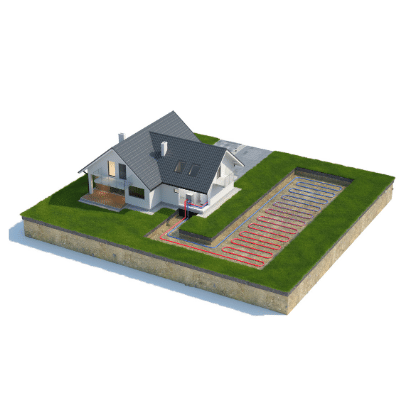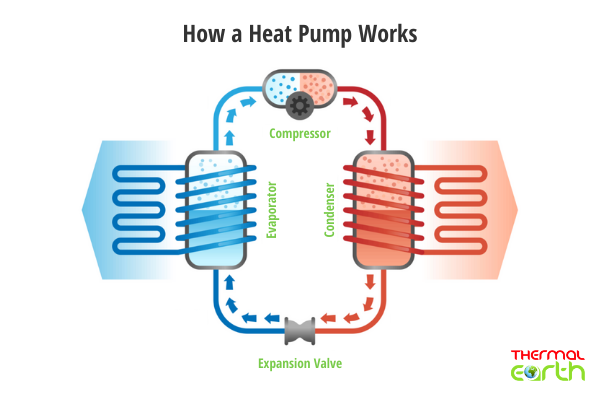Ground source heat pumps work by absorbing natural heat from the ground and transferring the heat into buildings to provide heating and hot water in a low-carbon, energy efficient way.
 Ground source heat pumps (GSHPs) are units which are installed inside a building, they are powered by electricity. Ground source heat pumps are connected to a series of pipes called ground collectors which are laid underground, either in horizontal trenches around 1.5 - 2 metres deep or in vertical boreholes, around 100 metre deep. At these depths, the ground maintains an average temperature of 10-12°C all year round.
Ground source heat pumps (GSHPs) are units which are installed inside a building, they are powered by electricity. Ground source heat pumps are connected to a series of pipes called ground collectors which are laid underground, either in horizontal trenches around 1.5 - 2 metres deep or in vertical boreholes, around 100 metre deep. At these depths, the ground maintains an average temperature of 10-12°C all year round.
A water/refrigerant fluid (often referred to as brine) is circulated through the ground collectors, absorbing thermal energy from the ground and circulating it back to the heat pump. A compressor inside the heat pump increases the temperature and it's then passed to a heat exchanger which transfers the heat to hot water cylinders, radiators and underfloor heating to provide space heating and hot water.
Once the fluid has delivered heat to your distribution system, it's then passed through an expansion valve which cools it before it repeats the circuit all over again.

For every 1kW of electricity used, ground source heat pumps produce around 4kWh of usable heat energy which is an efficiency of 400%. This excellent efficiency reduces your carbon footprint and delivers significant savings on your monthly energy bills.
Take a look at this video from the Energy Saving Trust for a visual guide on how ground source heat pumps work:
FAQs About HOW Ground Source Heat Pumps WORK
Do ground source heat pumps work when it’s cold?
Yes, ground source heat pumps work all year round. Heating schedules and preferred temperatures can be set on a thermostat or connected smartphone app and the system will deliver these temperatures in the same way you would expect a gas boiler to.
Do heat pumps need bigger radiators?
No, not necessarily. This is dependent on the size of the rooms you have, the number of rooms and how well insulated the property is. Heat pumps can work with a variety of different styles of radiators and also towel rails for bathrooms.
Will my radiators be hot to touch?
Heat pumps are designed to work at lower temperatures and offer greater efficiency by doing so. Instead of switching on and off like a gas boiler would, inverter heat pumps will continously alter their output (ranging between 30-100%) to meet the desired ambient temperature. This means that your radiators may feel cooler than they do with a gas boiler, but the ambient temperature of your property will meet your preferred settings.
What temperature can heat pumps deliver hot water?
As an example, the MasterTherm AquaMaster ground source heat pump can deliver hot water at 60°C and up to 70°C when you include an optional desuperheater. The average temperature for a hot shower is 40°C, giving plenty of scope for you to have higher temperature hot water should you need it.
Get a Quote
 Facebook
Facebook LinkedIn
LinkedIn Twitter
Twitter













